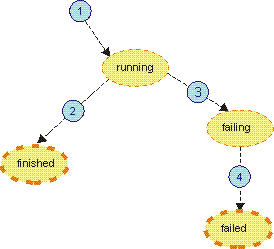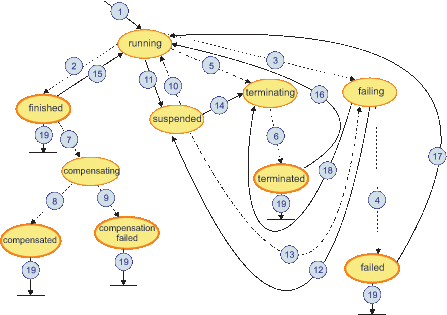IBM BPM, V8.0.1, All platforms > Get started with IBM BPM > Key concepts > BPEL processes and human tasks > BPEL processes overview > Life cycle of BPEL processes
State transition diagrams for BPEL process instances
Processes change state whenever something of significance happens during the lifecycle of the process instance.
For example, an API request causes a process in the running state to be put into the suspended state. State transition diagrams show the state transitions that can occur during the process lifecycle. Microflows and long-running processes have different state transition diagrams.
Conventions used in these diagrams
The state transitions in the diagrams are indicated by numbers. These numbers are then explained in the supporting text. In addition, the diagrams contain the following types of symbols:
| Symbol | Explanation |
|---|---|
|
| Transient state. These states are not visible. |
|
| Persistent state. |
|
| Transient end state. |
|
| Persistent end state. |
|
| State transitions that are triggered automatically by Business Flow Manager. |
|
| State transitions that are the result of an external interaction using an API. |
|
| State transitions that are controlled by Business Flow Manager, or are the result of an external interaction using an API. |
State transition diagram for microflow instances
A microflow is considered to be stateless because the process is always run in a transaction and instance information is not persisted for navigating the process instance. However, depending on the process definition and how Business Flow Manager is configured, the state of a microflow can be exposed in Common Base Events or in the audit log.
The following diagram shows the states that a microflow instance can have.
After normal initiation of the process instance, the first process state a process instance reaches is the running state (1). When a process instance runs normally through to completion, the process state changes from running to finished (2). If a fault reaches the process boundary, the process is put into the failing state (3). The process stays in the failing state while the fault handler runs. After this, the process instance is put into the failed state (4).
All of these state transitions are triggered by Business Flow Manager. After a microflow starts, you cannot influence these automatic steps.
State transition diagram for long-running process instances
A long-running process runs in several transactions. The state of a long-running process is persisted, and it is therefore visible. The following diagram shows the state transitions that can occur for a long-running process instance.

The running, finished, failing, and failed states, and the state transitions between them are the same as for microflows.
A process instance is terminated by either an external request, or a terminate activity. The termination of a process instance can span multiple navigation steps and therefore multiple chained transactions, for example, to terminate long-running activities or subprocesses. During this termination phase, the process instance is in the terminating state (5), (14), (18). When all of the long-running parts of the process are terminated, the state of the process instance also changes to terminated (6).
When a child process ends successfully and the parent process fails later, the child process can be compensated. During compensation, the child process is in the compensating state (7). If compensation ends successfully, the child process is put into the compensated state (8). If compensation is not successful, the child process is put into the compensation-failed state (9). These state transactions are initiated by the parent process automatically.
If the navigation of the process instance is still active, that is, it is in the running, or failing state, it can be suspended with an API request. It can then be reactivated either after a specified time, or by a resume request. The state of the process changes from running or failing to suspended (11), (12) with the suspend request, and from suspended to running or failing with the resume request (10), (13). A process in the suspended state can also be terminated (14). Only top-level process instances can be suspended and resumed. However, the suspend or resume state is propagated to the child processes.
When a process reaches one of the end states, finished, terminated, or failed, it can be started again with a restart API request (15), (16), (17). Only top-level process instances can be restarted, while only child process instances can be compensated.
A process instance can be deleted when it reaches an end state (19). The process can be deleted automatically if the automatically delete on completion attribute is set accordingly, or it can be triggered by an explicit delete request.
Related concepts:
Transactional behavior of BPEL processes






